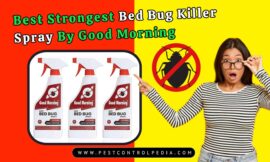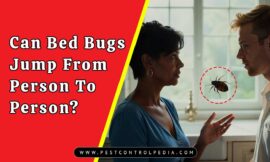Bed bugs are more than just a nuisance; they can disrupt your sleep and invade your peace of mind. As these tiny pests make a comeback in homes and hotels, many are left wondering about effective solutions for eradication.
Among the various products on the market, one name often pops up: HIT. But can this popular insecticide really deliver on its promises? In our exploration of whether can hit kill bed bugs, we’ll dive into the science behind pest control.
Understanding the behavior and biology of bed bugs is crucial to tackling an infestation. With their elusive nature and rapid reproduction, these pests require a strategic approach. Are traditional methods still the best, or does HIT spray offer a viable alternative?
In this article, we will uncover the truth behind does hit kill bed bugs, revealing insights that could change how you approach pest control in your home.
Table of Contents
ToggleUnderstanding Bed Bugs
Biology and Behavior
To effectively combat bed bugs, it's essential to understand their biology and behavior. These pests are small, nocturnal insects that feed on human blood, making them particularly unwelcome guests in our homes.
Life Cycle of Bed Bugs
The life cycle of bed bugs consists of several stages:
- Eggs: Tiny, white eggs that hatch within a week.
- Nymphs: Immature bed bugs that molt several times before becoming adults.
- Adults: Fully grown bed bugs that can live for several months without feeding.
Common Hiding Places and Feeding Habits
Bed bugs are skilled at hiding, making them difficult to detect. They often reside in:
- Bedding: Mattresses, box springs, and bed frames are prime locations.
- Furniture: Couches, chairs, and other upholstered items can harbor these pests.
- Cracks and Crevices: Walls, baseboards, and electrical outlets provide excellent hiding spots.
Signs of Infestation
Identifying a bed bug infestation early can help prevent a larger problem. Look for these common signs:
Identifying Bed Bug Bites
Bed bug bites often appear as small, red welts on the skin. They typically occur in clusters or lines and can be itchy or uncomfortable.
Visual Signs of Bed Bugs in the Home
In addition to bites, keep an eye out for:
- Dark Spots: Fecal stains on bedding or furniture indicate bed bug presence.
- Shed Skins: As nymphs grow, they shed their exoskeletons, which can be found in hiding spots.
- Live Bugs: Spotting adult bed bugs is a clear sign of an infestation.
Being aware of these signs and understanding the biology of bed bugs is crucial for effective pest control strategies. The sooner you identify an infestation, the easier it will be to manage it.
The Claims About HIT & Bed Bugs
Product Description
HIT is a popular insecticide designed to target various pests, including bed bugs. Its formulation aims to provide quick results, making it an appealing choice for those dealing with infestations.
Ingredients and Formulation of HIT
The effectiveness of HIT largely depends on its active ingredients, which are formulated to disrupt the nervous systems of insects. This targeted approach is intended to eliminate bed bugs upon contact.
Intended Use and Application Methods
Using HIT correctly is crucial for achieving desired results. Here are some common application methods:
- Spraying: Directly spraying infested areas, such as mattresses and furniture.
- Spot Treatment: Targeting specific areas where bed bugs are likely to hide.
- Aerosol Application: Utilizing aerosol cans for easy and controlled distribution.
Marketing Claims
The marketing for HIT often highlights its rapid action against bed bugs. Many advertisements claim that it can effectively eliminate these pests within a short period.
Promises Made by Manufacturers
Manufacturers frequently emphasize the following benefits:
- Quick Knockdown: Promises of immediate results upon application.
- Easy to Use: User-friendly instructions make it accessible for homeowners.
- Versatile Application: Suitable for various surfaces and environments.
Consumer Testimonials and Experiences
User reviews can provide insight into the product's effectiveness. While some consumers report success in controlling bed bug populations, others express dissatisfaction with the results.
Understanding both the claims and limitations of HIT is essential for anyone considering this product as part of their pest control strategy. A thorough evaluation can help determine if it meets your specific needs.
Effectiveness of HIT Against Bed Bugs
Expert Opinions
The effectiveness of HIT in controlling bed bugs has been a topic of discussion among pest control experts. While some believe it can be useful, others caution against relying solely on this product.
Summary of Studies and Expert Reviews
Research indicates that while HIT may kill bed bugs on contact, its residual effects are limited. Experts often recommend combining it with other methods for comprehensive control.
Comparison with Other Treatments
When considering pest control options, it's essential to compare HIT with traditional treatments. Here’s how it stacks up:
How HIT Stacks Up Against Traditional Pest Control Methods
- Effectiveness: Traditional pesticides often have longer-lasting effects compared to HIT.
- Application: Professional treatments, such as heat treatment, can eliminate all life stages of bed bugs.
- Safety: Some users prefer professional services for safety and thoroughness.
Limitations of Using HIT for Bed Bug Infestations
Despite its convenience, HIT has limitations that users should consider:
- Limited Residual Action: Its effectiveness diminishes over time, requiring frequent applications.
- Potential Resistance: Bed bugs may develop resistance to certain chemicals, reducing efficacy.
- Not Comprehensive: It may not eliminate hidden bed bugs or eggs effectively.
In summary, while HIT can be part of a bed bug management strategy, it is essential to explore additional methods for a more effective approach. A multi-faceted strategy often yields the best results in controlling these pests.
Alternative Solutions for Bed Bug Control
Professional Pest Control Services
When dealing with a significant bed bug infestation, professional pest control services can provide effective solutions. These experts have access to advanced techniques and products that may not be available to the average consumer.
Overview of Professional Treatment Options
Professional services often utilize a combination of methods to ensure thorough eradication. Common treatments include:
- Heat Treatment: Raising the temperature of infested areas to kill all life stages of bed bugs.
- Pesticide Application: Using specialized insecticides that target bed bugs effectively.
- Integrated Pest Management (IPM): Combining various strategies for long-term control.
DIY Methods
If professional services are not an option, several DIY methods can help manage bed bug populations. While these may not be as comprehensive, they can be effective when used correctly.
Effective Home Remedies and Preventive Measures
Consider these DIY approaches to tackle bed bugs:
- Vacuuming: Regularly vacuuming carpets, furniture, and bedding can help remove bed bugs and their eggs.
- Steam Cleaning: Using steam can kill bed bugs on contact, especially in seams and crevices.
- Encasements: Using mattress and box spring encasements can trap bed bugs inside and prevent new infestations.
Integrated Pest Management (IPM) Strategies
An effective approach to bed bug control is Integrated Pest Management (IPM). This strategy combines multiple methods to achieve long-lasting results.
Combining Various Methods for Effective Control
IPM strategies may include:
- Monitoring: Regular inspections to catch infestations early.
- Cultural Practices: Reducing clutter and maintaining cleanliness to minimize hiding spots.
- Chemical Treatments: Using targeted pesticides as needed, while following safety guidelines.
By exploring these alternative solutions, homeowners can develop a comprehensive strategy for controlling bed bugs. Combining professional help with DIY methods often leads to the best outcomes in managing these persistent pests.
Case Studies
Case Study 1: Residential Infestation
A family discovered a severe bed bug infestation in their home. They initially tried using HIT, but the results were disappointing. Despite multiple applications, the bed bugs persisted, leading them to seek professional help.
Scenario Detailing an Unsuccessful Attempt
After applying HIT as directed, the family noticed some immediate kills but failed to address hidden populations. The infestation continued to spread, highlighting the limitations of relying solely on one product for control.
Case Study 2: Professional Intervention
In another case, a small apartment complex faced a significant bed bug outbreak. The management opted for professional pest control services, which utilized heat treatment and targeted pesticides.
A Successful Case Where Professional Pest Control Eliminated Bed Bugs
The professionals conducted thorough inspections and treated all affected units. Within a few weeks, the infestation was completely eradicated, demonstrating the effectiveness of comprehensive pest management strategies.
Case Study 3: DIY Success Story
A homeowner discovered bed bugs in their bedroom and decided to tackle the problem using DIY methods. They combined vacuuming, steam cleaning, and encasements to manage the situation.
An Example of a Homeowner Using Alternative Methods
By regularly vacuuming and applying steam to infested areas, along with encasing their mattress, the homeowner successfully controlled the infestation. This case illustrates that with diligence and the right techniques, DIY solutions can be effective.
These case studies highlight different approaches to managing bed bug infestations. Whether through professional services or DIY methods, understanding the options available can lead to successful outcomes in controlling these pests.
Frequently Asked Questions - FAQS
Q. Can Godrej HIT be used to kill bed bugs effectively?
A. Yes, Godrej HIT is effective against bed bugs. Its powerful formulation targets these pests directly, ensuring quick elimination. It penetrates their hiding spots, making it a reliable choice for managing bed bug infestations in homes.
Q. What are the best methods to prevent bed bugs from coming back after treatment?
A. To prevent bed bugs from returning, regularly wash bedding in hot water, vacuum frequently, and seal cracks in furniture. Additionally, using bed bug-proof encasements on mattresses can create a barrier that deters reinfestation.
Q. How does steam cleaning compare to chemical sprays for bed bug removal?
A. Steam cleaning is a non-toxic method that kills bed bugs and their eggs using high temperatures. In contrast, chemical sprays provide immediate results but may contain harmful substances. Both methods can be effective when used correctly.
Q. Are there any non-toxic alternatives to Godrej HIT for bed bug control?
A. Yes, several non-toxic alternatives exist for bed bug control, including diatomaceous earth and essential oils like tea tree or lavender oil. These options are safer for homes with children and pets while still being effective against bed bugs.
Q. What precautions should I take when using Godrej HIT in a home with pets?
A. When using Godrej HIT, ensure pets are removed from the area during application. Ventilate the space well and allow sufficient time for the product to dry before allowing pets to re-enter to avoid any potential health risks.
Conclusion
Summary of Findings
Throughout this article, we explored the question of whether can hit kill bed bugs. While HIT can provide some immediate results, its effectiveness may be limited when addressing a full-blown infestation.
Key Takeaways
- Understanding Bed Bugs: Knowledge of their biology and behavior is crucial for effective control.
- Product Limitations: HIT may not be sufficient as a standalone solution for bed bug management.
- Importance of Comprehensive Strategies: Combining professional help, DIY methods, and preventive measures often yields the best results.
Final Recommendations
If you suspect a bed bug infestation, consider a multi-faceted approach. Start with thorough inspections and consider professional pest control services for severe cases.
For those opting for DIY methods, be diligent in your efforts. Regular cleaning, vacuuming, and using encasements can significantly reduce bed bug populations.
Ultimately, taking proactive steps and understanding the available options will empower you to effectively manage and eliminate bed bugs from your home.





